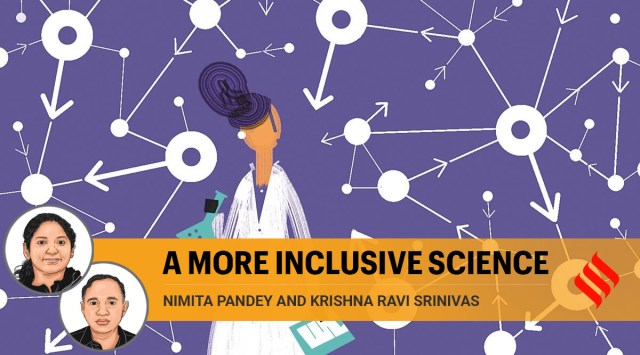
There has been a lot of discussion and debate on the underrepresentation of women in the sciences. This exists across the entire career trajectory — in recruitment and promotion, in awards, in selection to science academies as members/fellows and in leadership positions in scientific institutions. The status of women’s representation in science academies reflects their overall position in the scientific community. Science academies have strict criteria for electing fellows; to be elected as a fellow in one or more academies of science is a mark of recognition and achievement. Even today, a fellowship of academies like the Royal Society (of Britain) is considered respectable and prestigious.
Historically, academies have been male bastions with the significant exclusion of women scientists, irrespective of their contributions and work. The early part of the 20th century witnessed the acceptance of women scientists as members in many of the European academies. The global picture of science academies also reveals considerable underrepresentation of women. A recent study done jointly by GenderInSITE (Gender in Science, Innovation, Technology and Engineering), the InterAcademy Partnership (IAP) and the International Science Council (ISC) shows that elected membership of women in senior academies increased marginally from 13 per cent in 2015 to 16 per cent in 2020. However, in 19 academies it is 10 per cent or less. In the case of young academies, the position is better although there is under-representation as the average share is 42 per cent. Among the senior academies, the Academy of Sciences of Cuba leads with 33 per cent.
In 2015, a similar study stirred discussion among academies on this issue which led to various recommendations. Unfortunately, in 2020, it was found that only a third of them (34 per cent) had developed a specific strategy to enhance women’s participation and merely 16 per cent of them have a budget for activities to promote gender equality. What is more worrisome is the severe under-representation in academies in specific fields; in engineering sciences and mathematics, women are just 10 per cent and 8 per cent respectively. Undoubtedly, women scientists have a long way to go to be accepted and elected as equals. While the given issue emanates from the larger problem of the underrepresentation of women in all spheres of life, its persistence in science shows that scientists and science academies need to develop policies and strategies to enhance the representation of women. More importantly, science academies have to reflect upon their role and contributions to promote and retain women in science, thereby making science inclusive and sensitive.
In the Indian context, the survey conducted in 2020 showed that out of 1,044 members of the Indian National Science Academy (INSA), only 89 are women, amounting to 9 per cent. In 2015, it was worse with 6 per cent women scientist members out of 864 members. Similarly, the governing body of INSA had seven women out of 31 members in 2020, while there were no women members in 2015. The three academies, the Indian National Science Academies (INSA), the Indian Academy of Sciences (IAS) and the National Academies (NAS) are striving to enhance the representation of women in science, including in professional bodies and related institutions. A report was published in 2016, pointing out the status of women in science outlining various suggestions to tackle the issue. In 2019, INSA elected its first woman president, Chandrima Shaha. Some of the recent initiatives of the IAS are notable and pioneering. Recognising gender equality as enshrined in the Constitution and the reality of discrimination, sexual harassment, gender bias and inadequacies in institutional infrastructures, it has adopted the five policy commitments. “Promote gender equality as an explicit human right; identify and eliminate practices that create systemic and structural impediments to the advancement of women in science; support the empowerment of women to enable them to flourish in the scientific profession; identify potential risks and hindrances to women in their pursuit of science and implement strategies to eliminate them; and engage with the Government of India, scientific institutions and the civil society to promote and support gender equality in general, and in science in particular.”
Each commitment has its own significance and can contribute immensely to creating synergies between principles and actions. The academy’s assurance to set specific goals and periodically monitor progress are steps in the right direction. The eight guidelines adopted by the IAS indicate its willingness to walk the talk. It is noteworthy that the IAS is prioritising addressing issues of under-representation within the institution rather than making general observations and suggestions.
The guideline also endorses significant representation of women in all activities, functioning and positions of IAS. It will ensure more visibility for women in IAS and create greater impact, thereby addressing the issue of gender equality in the true sense, rather than reducing it to tokenism. The other six guidelines revolve around the aforementioned ideas.
Efforts to ensure gender equity in science should not be limited to the science academies. Much needs to be done by all stakeholders. However, it is truly a clarion call when academies set a precedent in matters of women’s under-representation by acting internally, without any external compulsion or pressure. In light of the thrust on gender equity and inclusion in India’s forthcoming Science, Technology, and Innovation Policy (STIP), we optimistically anticipate the relevance of science academies in implementing recommendations to promote and retain women as well as in creating an enabling milieu to achieve gender equality in science.
This column first appeared in the print edition on February 24, 2022 under the title ‘A more inclusive science’. Pandey is postdoctoral fellow, Centre for Policy Research, Indian Institute of Science (IISc) and Srinivas is Senior Fellow and Consultant, Research and Information System for Developing Countries.